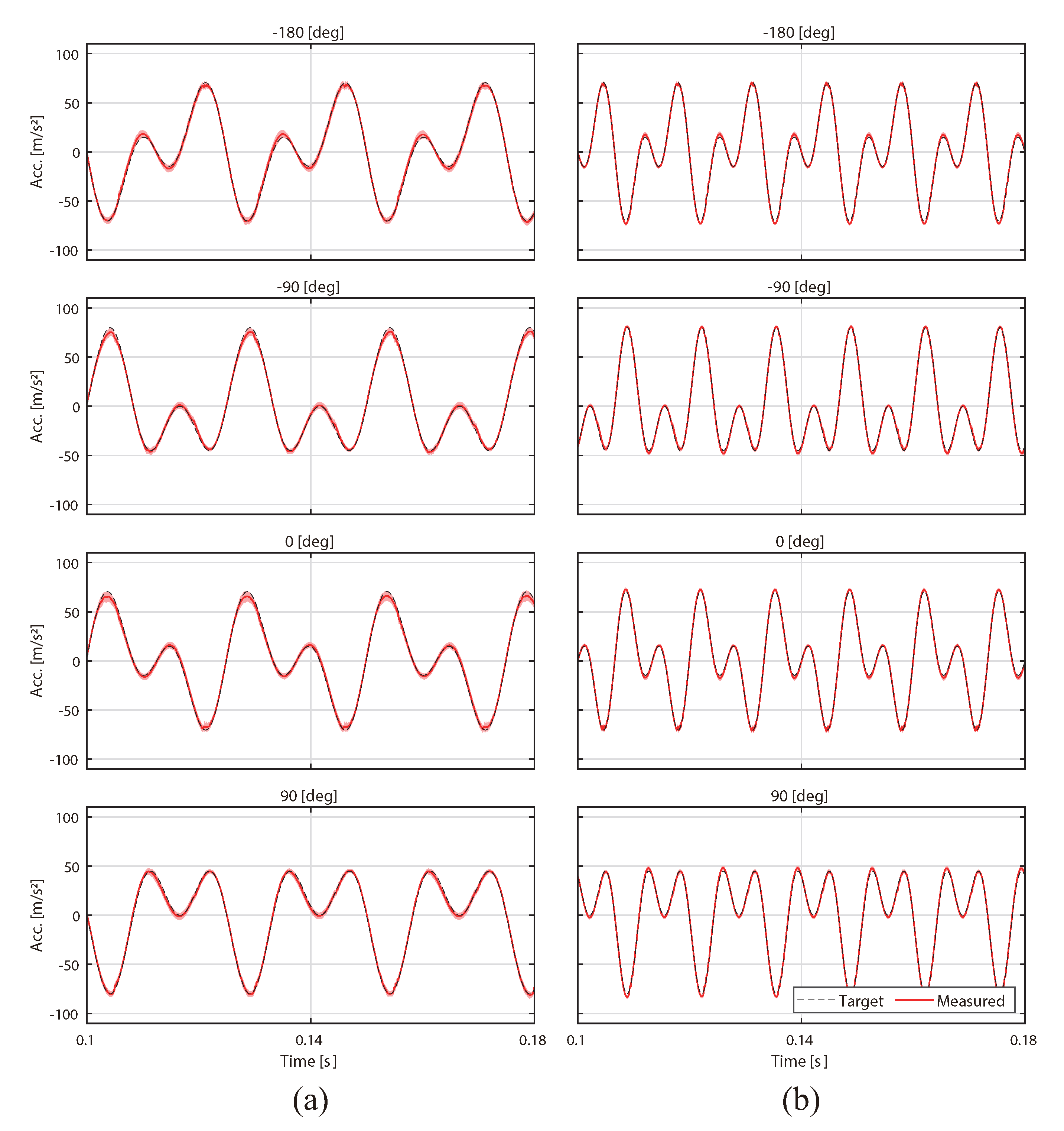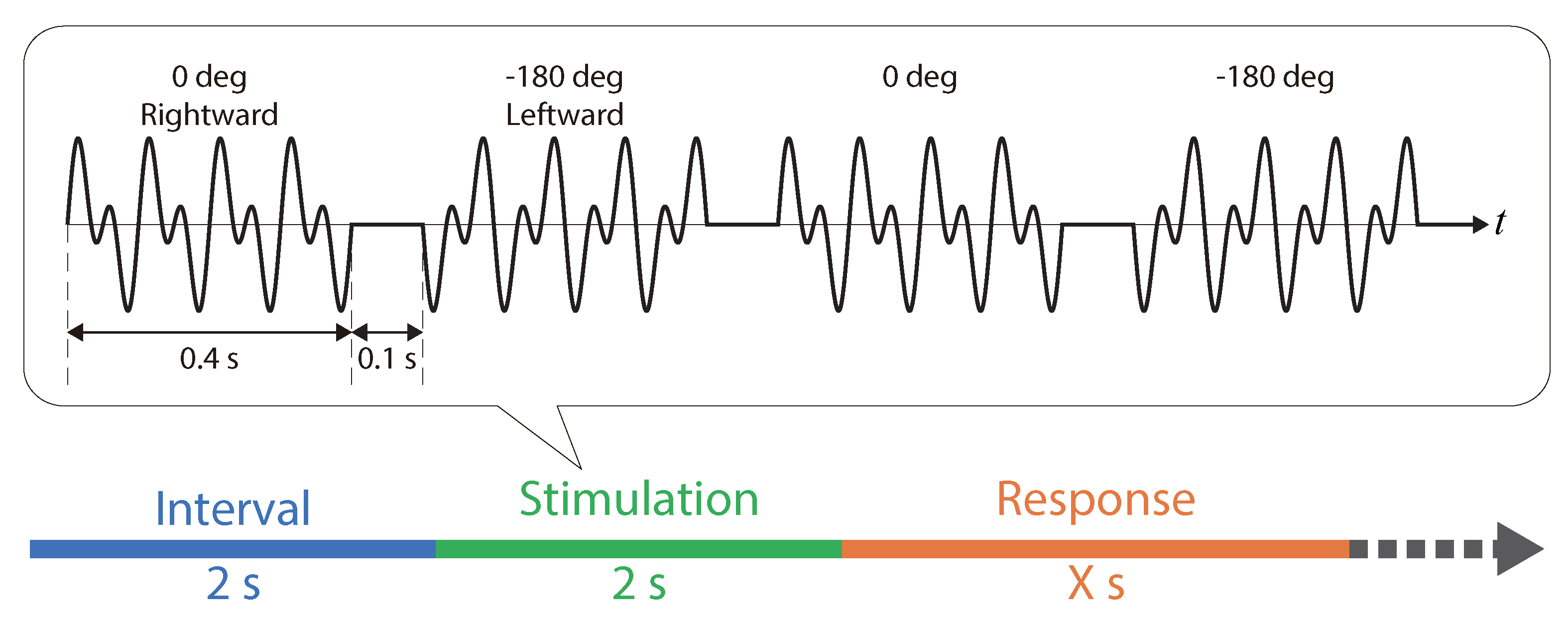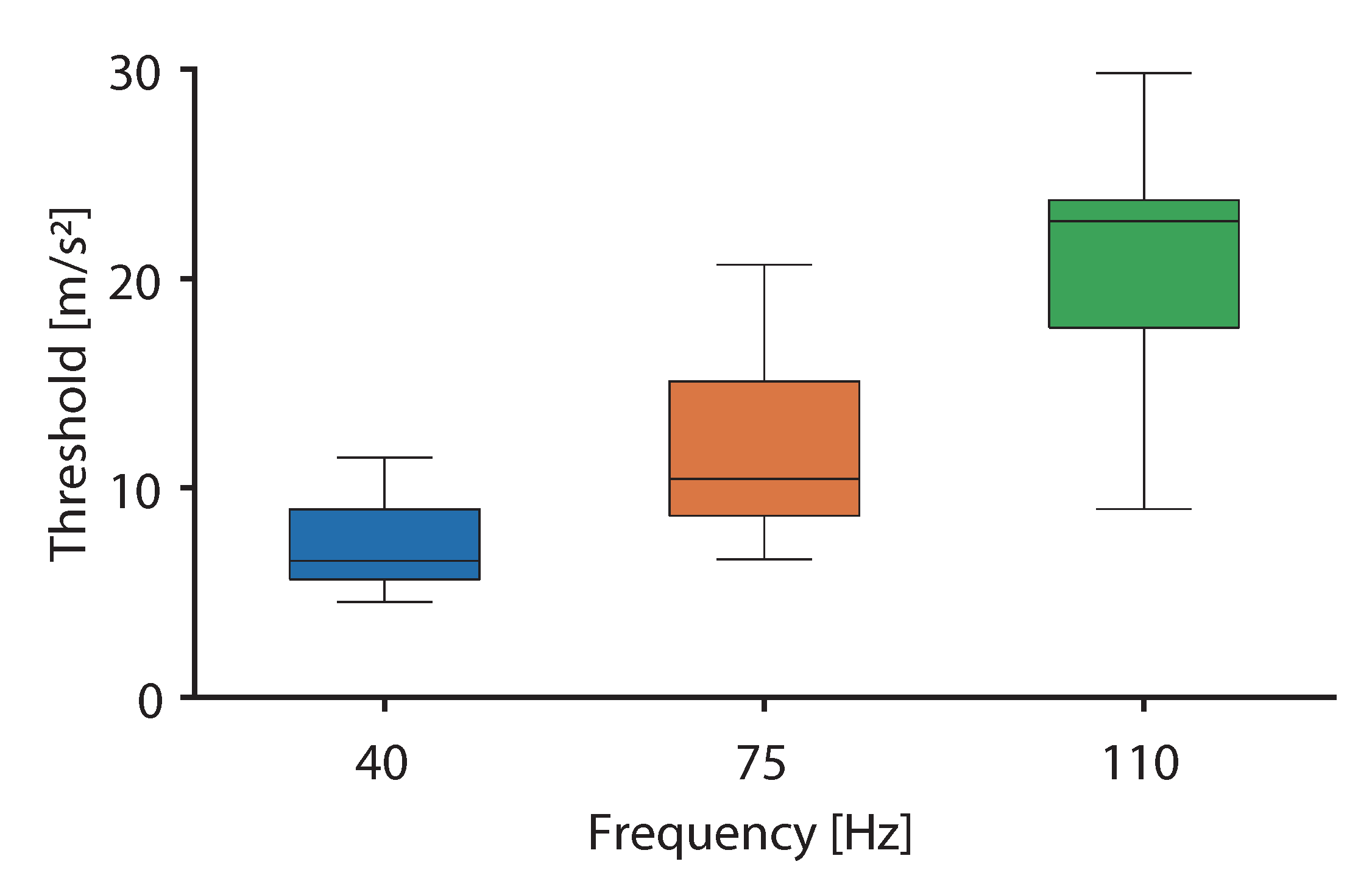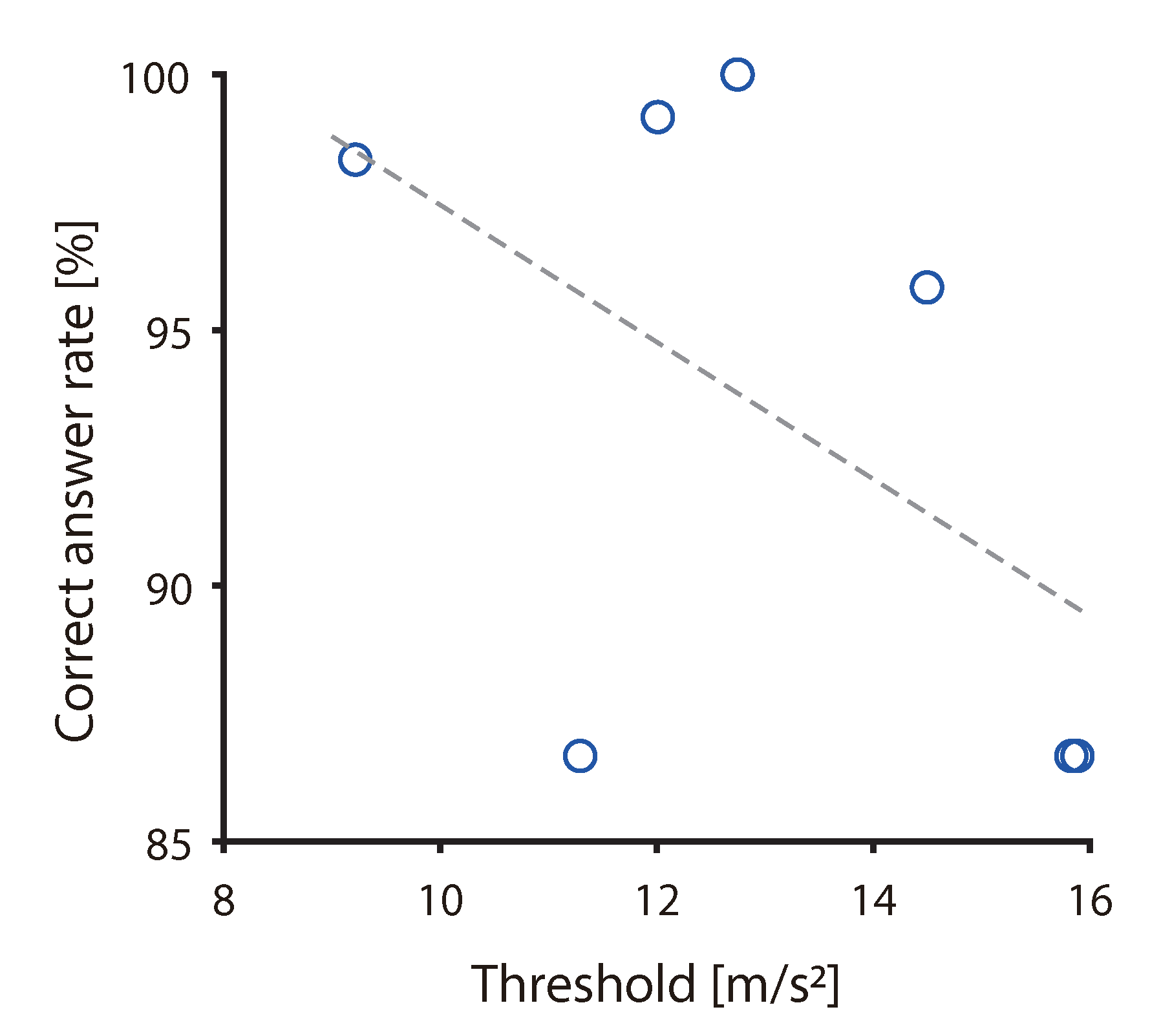Effects of Asymmetric Vibration Frequency on Pulling Illusions
Abstract
:1. Introduction
2. Experiment I: Effects Owing to Frequency and the Vibration Waveform
2.1. Method
2.1.1. Participants
2.1.2. Stimuli
2.1.3. Apparatus
2.1.4. Procedure
2.1.5. Data Analysis
2.2. Results
3. Experiment II: The Effect of Frequency Against Threshold that Induced the Pulling Illusion
3.1. Method
3.1.1. Participants
3.1.2. Stimuli
3.1.3. Apparatus and Procedure
3.1.4. Data Analysis
3.2. Results
4. Discussion
4.1. General Discussion
4.2. Discussion of Individual Differences
5. Conclusions
Author Contributions
Funding
Conflicts of Interest
References
- Amemiya, T.; Ando, H.; Maeda, T. Lead-Me Interface for a Pulling Sensation from Hand-held Devices. ACM Trans. Appl. Percept. 2008, 5, 1–17. [Google Scholar] [CrossRef]
- Amemiya, T.; Sugiyama, H. Orienting Kinesthetically: A Haptic Handheld Wayfinder for People with Visual Impairments. ACM Trans. Access. Comput. 2010, 3, 1–23. [Google Scholar] [CrossRef]
- Nakamura, N.; Fukui, Y. Development of Fingertip Type Non-grounding Force Feedback Display. In Proceedings of the Second Joint EuroHaptics Conference and Symposium on Haptic Interfaces for Virtual Environment and Teleoperator Systems (WHC’07), Tsukaba, Japan, 22–24 March 2007; pp. 582–583. [Google Scholar]
- Tappeiner, H.W.; Klatzky, R.L.; Unger, B.; Hollis, R. Good vibrations: Asymmetric vibrations for directional haptic cues. In Proceedings of the World Haptics 2009—Third Joint EuroHaptics conference and Symposium on Haptic Interfaces for Virtual Environment and Teleoperator Systems, Salt Lake City, UT, USA, 18–20 March 2009; pp. 285–289. [Google Scholar]
- Goodwin, G.M.; McCloskey, D.I.; Matthews, P.B. Proprioceptive Illusions Induced by Muscle Vibration: Contribution by Muscle Spindles to Perception? Science 1972, 174, 1382–1384. [Google Scholar] [CrossRef] [PubMed]
- Culbertson, H.; Walker, J.M.; Okamura, A.M. Modeling and Design of Asymmetric Vibrations to Induce Ungrounded Pulling Sensation Through Asymmetric Skin Displacement. In Proceedings of the Haptics Symposium 2016, Philadelphia, PA, USA, 8–11 April 2016; pp. 27–33. [Google Scholar]
- Rekimoto, J. Traxion: A tactile interaction device with virtual force sensation. In Proceedings of the 26th Annual ACM Symposium on User Interface Software and Technology, St. Andrews Scotland, UK, 8–11 October 2013; pp. 427–431. [Google Scholar]
- Amemiya, T.; Gomi, H. Distinct pseudo-attraction force sensation by a thumb-sized vibrator that oscillates asymmetrically. In Proceedings of the 9th International Conference, EuroHaptics 2014, Versailles, France, 24–26 June 2014; pp. 88–95. [Google Scholar]
- Tanabe, T.; Yano, H.; Iwata, H. Evaluation of the Perceptual Characteristics of a Force Induced by Asymmetric Vibrations. IEEE Trans. Haptics 2018, 11, 220–231. [Google Scholar] [CrossRef] [PubMed]
- Kim, H.; Yi, H.; Lee, H.; Lee, W. HapCube: A Wearable Tactile Device to Provide Tangential and Normal Pseudo-Force Feedback on a Fingertip. In Proceedings of the 2018 CHI Conference on Human Factors in Computing System, Montreal, QC, Canada, 21–26 April 2018; pp. 1–13. [Google Scholar]
- Choinière, J.; Gosselin, C. Development and Experimental Validation of a Haptic Compass Based on Asymmetric Torque Stimuli. IEEE Trans. Haptics 2017, 10, 29–39. [Google Scholar] [CrossRef] [PubMed]
- Takamuku, S.; Amemiya, T.; Ito, S.; Gomi, H. Design of Illusory Force Sensation for Virtual Fishing. Trans. Hum. Interface Soc. 2016, 18, 87–94. [Google Scholar]
- Choi, I.; Culbertson, H.; Miller, M.R.; Olwal, A.; Follmer, S. Grabity: A Wearable Haptic Interface for Simulating Weight and Grasping in Virtual Reality. In Proceedings of the 30th Annual ACM Symposium on User Interface Software and Technology, Québec City, QC, Canada, 22–25 October 2017; pp. 119–130. [Google Scholar]
- Saddik, A. Digital Twins: The Convergence of Multimedia Technologies. IEEE Multimed. 2018, 25, 87–92. [Google Scholar] [CrossRef]
- Bolanowski, S.J.; Gescheider, G.A.; Verrillo, R.T.; Checkosky, C.M. Four channels mediate the mechanical aspects of touch. J. Acoust. Soc. Am. 1988, 84, 1680–1694. [Google Scholar] [CrossRef] [PubMed]
- Choi, S.; Kuchenbecker, K.J. Vibrotactile Display: Perception, Technology, and Applications. Proc. IEEE 2013, 101, 2093–2104. [Google Scholar] [CrossRef]
- McMahan, W.; Kuchenbecker, K.J. Dynamic modeling and control of voice-coil actuators for high-fidelity display of haptic vibrations. In Proceedings of the Haptics Symposium 2014, Houston, TX, USA, 23–26 February 2014; pp. 115–122. [Google Scholar]
- Tanabe, T.; Yano, H.; Endo, H.; Ino, S.; Iwata, H. Pulling Illusion Based on the Phase Difference of the Frequency Components of Asymmetric Vibrations. IEEE/ASME Trans. Mechatron. 2020, 1, preprint. [Google Scholar] [CrossRef]
- Amemiya, T. Haptic Interface Technologies Using Perceptual Illusions. In Proceedings of the 20th International Conference on Human-Computer Interaction, Sendai, Japan, 28 September–2 October 2020; pp. 168–174. [Google Scholar]
- Bell, J.; Bolanowski, S.; Holmes, M.H. The structure and function of pacinian corpuscles: A review. Prog. Neurobiol. 1994, 42, 79–128. [Google Scholar] [CrossRef]
- International Organization for Standardization. Mechanical Vibration and Shock? Evaluation of Human Exposure to Whole-Body Vibration? Part 1: General Requirements. ISO 2631-1; International Organization for Standardization: Geneva, Switzerland, 1997. [Google Scholar]
- Dandu, B.; Shao, Y.; Stanley, A.; Visell, Y. Spatiotemporal Haptic Effects from a Single Actuator via Spectral Control of Cutaneous Wave Propagation. In Proceedings of the 2019 IEEE World Haptics Conference (WHC), Tokyo, Japan, 9–12 July 2019; pp. 425–430. [Google Scholar]









Publisher’s Note: MDPI stays neutral with regard to jurisdictional claims in published maps and institutional affiliations. |
© 2020 by the authors. Licensee MDPI, Basel, Switzerland. This article is an open access article distributed under the terms and conditions of the Creative Commons Attribution (CC BY) license (http://creativecommons.org/licenses/by/4.0/).
Share and Cite
Tanabe, T.; Endo, H.; Ino, S. Effects of Asymmetric Vibration Frequency on Pulling Illusions. Sensors 2020, 20, 7086. https://doi.org/10.3390/s20247086
Tanabe T, Endo H, Ino S. Effects of Asymmetric Vibration Frequency on Pulling Illusions. Sensors. 2020; 20(24):7086. https://doi.org/10.3390/s20247086
Chicago/Turabian StyleTanabe, Takeshi, Hiroshi Endo, and Shuichi Ino. 2020. "Effects of Asymmetric Vibration Frequency on Pulling Illusions" Sensors 20, no. 24: 7086. https://doi.org/10.3390/s20247086




